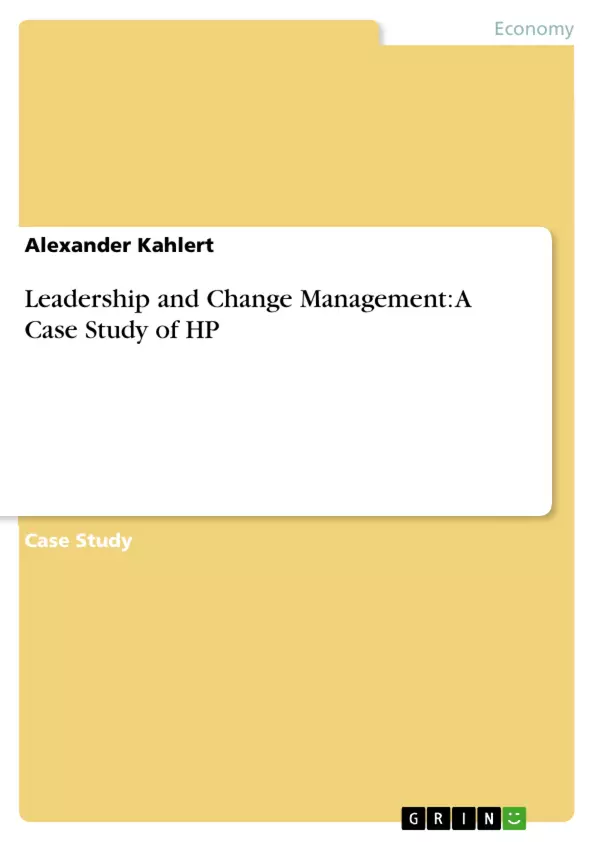The paper discusses the former issues of HP. Based on that insights, new leadership and organizational structures are discussed and proposed to bring HP back on a growth track.
Various models from modern leadership literature and best practices from peer group companies are used to evaluate recommendations.
Table of Contents
- Introduction
- Strategy analysis for the company HP
- Current challenges of HP
- HP's organizational complexities
- Leadership approach of HP's senior management
- Strategic Change Plan for HP
- Determination of the required type of change
- Execution plan of the change path
- Required leadership skills for HP's revolution
- Results
- References
Objectives and Key Themes
This term paper aims to analyze Hewlett-Packard's (HP) challenges in 2012 and propose a strategic turnaround plan. The analysis focuses on change management and leadership theories to facilitate a successful transformation. The paper explores HP's internal and external challenges to develop a comprehensive transformation strategy.
- Analysis of HP's challenges in 2012 (financial performance, competition, innovation)
- Examination of HP's organizational complexities and internal culture clashes
- Assessment of HP's leadership approach and its shortcomings
- Development of a strategic change plan using relevant change management models
- Identification of required leadership skills for successful transformation
Chapter Summaries
Introduction: This introductory chapter sets the stage by introducing Hewlett-Packard (HP) as an international technology company with a diverse product portfolio, encompassing software, hardware, and services. It highlights the 2012 restructuring into two separate entities: HP Inc. (focused on hardware) and Hewlett Packard Enterprise (HPE), emphasizing the volatility in their share prices. The chapter underscores HP's struggles with internal structures, cultural clashes, and a lack of leadership and change management, leading to the central research question: How can a successful strategic turnaround of HP be structured and implemented? The paper's structure, focusing on change management and leadership theories, is also outlined here.
Strategy analysis for the company HP: This chapter delves into a detailed analysis of HP's challenges in 2012, examining them through the lens of current challenges, organizational complexities, and leadership approaches. It highlights declining financial performance, increased investor pressure, intense competition, a lack of innovation, and difficulties in talent acquisition and financing. The chapter also mentions the impact of legal issues, like the TomorrowNow case, on the company's ability to focus on critical strategic decisions. The interrelation of these issues within the context of the company structure is analyzed.
Strategic Change Plan for HP: This chapter is dedicated to proposing a detailed plan for HP's strategic transformation, addressing the challenges identified in the previous chapter. It will likely outline specific change management models and approaches to implement the necessary changes within the organization. This plan would also include the necessary steps and strategies for overcoming the obstacles hindering HP's growth and success. Detailed recommendations for effective change management and leadership would be expected.
Keywords
Hewlett-Packard (HP), strategic turnaround, change management, leadership, organizational complexity, innovation, financial performance, competition, transformation plan, strategic analysis.
HP Strategic Turnaround: Frequently Asked Questions
What is the main topic of this document?
This document presents a comprehensive analysis of Hewlett-Packard's (HP) challenges in 2012 and proposes a strategic turnaround plan. It focuses on change management and leadership theories to guide HP's transformation.
What are the key themes explored in this paper?
The key themes include analyzing HP's challenges (financial performance, competition, innovation), examining organizational complexities and internal culture clashes, assessing HP's leadership approach, developing a strategic change plan using relevant change management models, and identifying required leadership skills for successful transformation.
What challenges faced HP in 2012?
HP faced numerous challenges in 2012, including declining financial performance, increased investor pressure, intense competition, a lack of innovation, difficulties in talent acquisition and financing, and the impact of legal issues (like the TomorrowNow case) on strategic decision-making. Internal structural issues and cultural clashes also significantly hindered progress.
What is the structure of the analysis?
The analysis is structured into several key sections: an introduction outlining HP's situation and research question; a strategy analysis detailing HP's challenges in 2012; a strategic change plan proposing solutions; and concluding remarks including references.
What kind of change management models are discussed?
While specific models aren't explicitly named, the paper implies the use of relevant change management models and approaches to develop a comprehensive transformation strategy for HP. The plan likely includes detailed steps and strategies to overcome obstacles.
What leadership skills are identified as crucial for HP's transformation?
The paper identifies the need for specific leadership skills to drive successful transformation but does not explicitly list them. The analysis focuses on the shortcomings of existing leadership and the need for an improved approach.
What is the proposed solution for HP's problems?
The document proposes a detailed strategic change plan to address HP's identified challenges. This plan likely includes specific recommendations for effective change management and leadership to facilitate the company's turnaround.
What are the chapter summaries?
The introduction sets the stage, the strategy analysis details HP's 2012 challenges, and the strategic change plan proposes a detailed turnaround strategy. The conclusion summarizes findings and offers concluding remarks.
What are the keywords associated with this analysis?
Keywords include Hewlett-Packard (HP), strategic turnaround, change management, leadership, organizational complexity, innovation, financial performance, competition, transformation plan, and strategic analysis.
What is the overall objective of this paper?
The main objective is to analyze HP's challenges in 2012 and propose a practical and effective strategic turnaround plan based on sound change management and leadership principles.
- Quote paper
- Alexander Kahlert (Author), 2019, Leadership and Change Management: A Case Study of HP, Munich, GRIN Verlag, https://www.grin.com/document/504100



